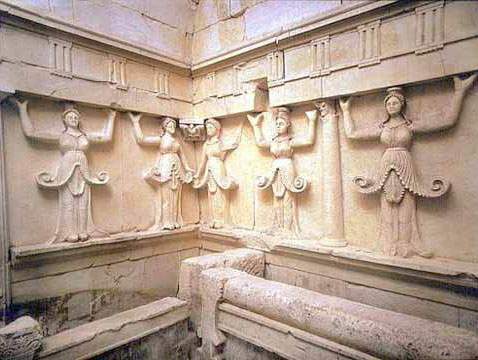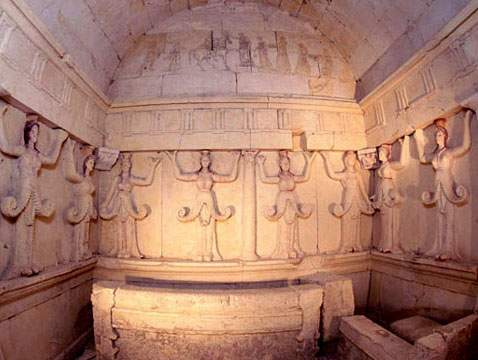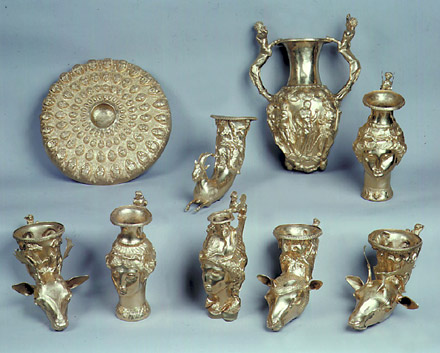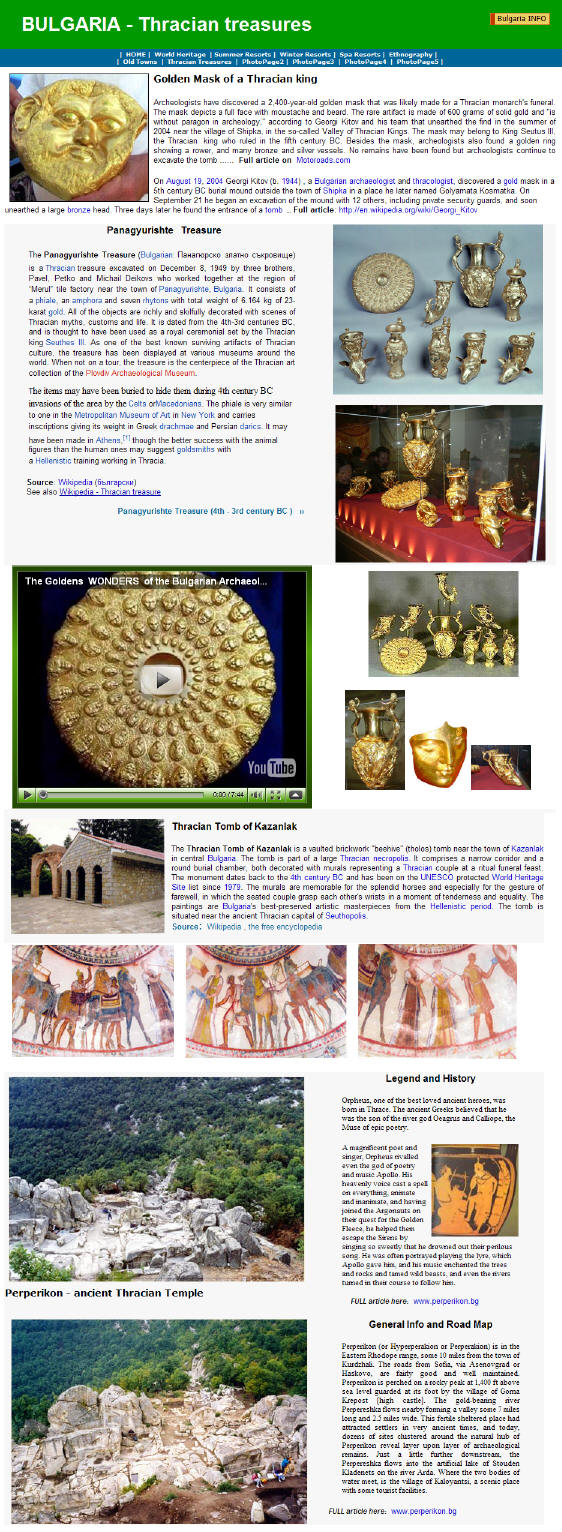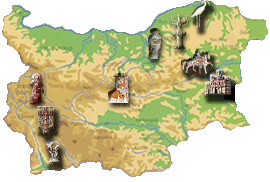|
|
Thracian tomb Sveshtari
The Thracian Tomb of Sveshtari
is situated 2,5
km southwest of the village of
Sveshtari,
Razgrad Province, which is located 42 km
northeast of
Razgrad, in the northeast of
Bulgaria.
Discovered in
1982, the 3rd century BC
Thracian
tomb reflects the fundamental structural
principles of Thracian cult buildings. The tomb's
architectural decor is considered to be unique, with
polychrome half-human, half-plant
caryatids and painted murals. Ten female figures
are carved in high relief on the walls of the
central chamber and the decorations of the lunette
in its vault are the only examples of this type
found so far in the lands one inhabited by
Thracians. It is thought of as a remarkable reminder
of the culture of the
Getae (also known as
Dacians), a Thracian people who were in contact
with the
Hellenistic and
Hyperborean worlds.
Source:
http://en.wikipedia.org/wiki/Thracian_tomb_of_Sveshtari
|
|
|
|
Bulgarian
Monasteries
Bulgaria adopted the Christianity in 865. Prince Boris
(852-889) who considered monarchism useful for purely State interests,
built solid monasteries and churches inspiring respect and a sense of
security, first in the capital city of Pliska and near it. The second
Christian ruler, the youngest son of Boris, Tsar Simeon (893-927),
erected the new capital of Preslav, and founded monasteries in remote
and quiet places creating conditions for educational and literary work
of writers and theologians. The monasteries were to hammer out the
foundations of the future culture and spiritual community. Round about
886, Prince Boris I accommodated the disciples of Cyril and Methodius,
the creators of the Slavonic-Bulgarian letters, at St. Panteleimon's
Monastery built upon his orders near Preslav. One of the disciples of
Cyril and Methodius, Naoum, established here the new Old-Bulgarian
alphabet - the so called Cyrillic alphabet (the bases of present-day
Bulgarian letters).
|
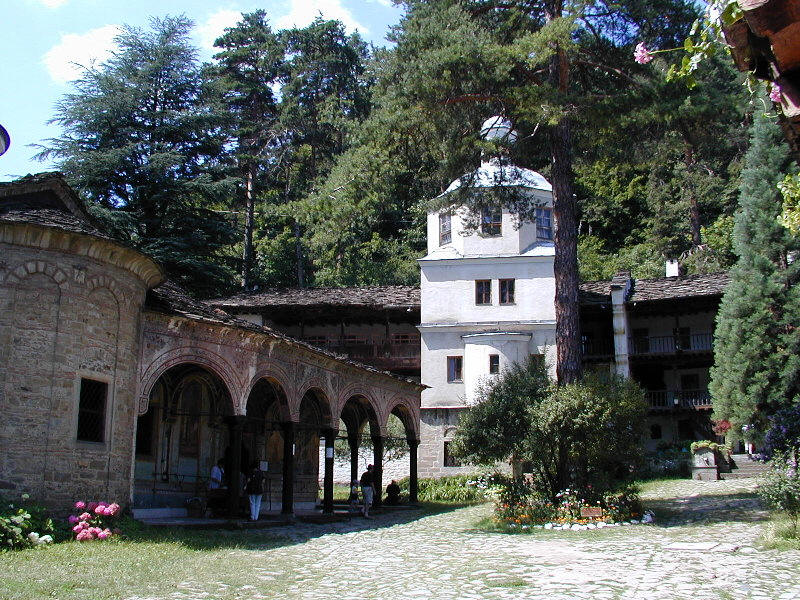
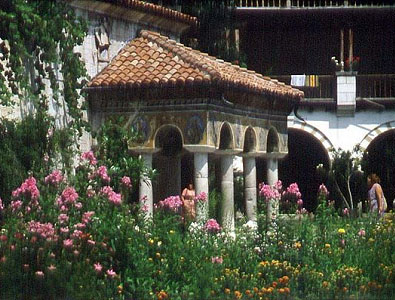 |
The TROYAN Monastery "St. Holy Virgin"
National tourist object. Founded in 1600. The present monastery was
built in 1835. Mural paintings made by the famous Zahari Zograph and
Dimiter Zograph. Museum collection that keeps early printed books,
scripts and icons. A chronicle dates back the foundation of the monastery in
the year 1600; nothing but the throne stone of the church remains from
that time. The Troyan Monastery belongs completely to
the Bulgarian National Revival period. In 1872 Vassil Levski set up here
a secret revolutionary committee, which was joined by all the monks
headed by the Father Superior Macarius. Four years later, the monastery
become a citadel of the 1876 April Uprising. Fortunately, most of the
great works of National Revival art have survived. The iconostasis of
the main church made in 1839 is a masterpiece of woodcarving. Amazing in
its originality, is the much earlier carving of the holy altar gates in
the St. Nikola Chapel.
The Troyan Monastery, is known for the
creative work of Zahary Zograph who painted both the exterior and
interior of the main church (a rare practice for the time) built in
1835. Besides, he painted a completely secular group portrait of the
monastic brotherhood in the refectory - something highly unusual for the
time. Here, Zahary Zograph repeated the social and moral "experiments"
in religious painting (the compositions Doomsday and the Wheel of
Life), left his second self-portrait signed with amazing self
confidence in spite of the Ottoman bondage, and painted the figures of
Bulgarian and Russian saints. Particularly valuable among the
multitude of manuscripts and incunabula are the so-called Troyan
Homilies of 17th century. The monastery's "printery" in which fine
graphic works, including many landscapes, were made, was widely known.
See also:
Nikola Gruev's
Photo gallery
|
 |
Dryanovo Monastery
The Dryanovo
Monastery (Дряновски манастир) is a
functioning
Bulgarian Orthodox monastery situated in
the
Andaka River Valley in the central part
of
Bulgaria five kilometers away from the
town of
Dryanovo. It was founded in the
12th century, during the
Second Bulgarian Empire, and is
dedicated to
Archangel Michael. Twice burnt down and
pillaged during the
Ottoman rule of Bulgaria, the monastery
was restored at it present place in
1845. It was the site of several battles
during the
April Uprising of
1876.
Full article on Wikipedia, the free
encyclopedia
See also:
Nikola Gruev's Photo gallery of the Dryanovo
Monastery
|
The RILA Monastery
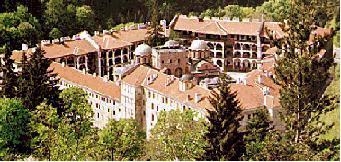
World Cultural
Heritage (UNESCO object) National tourist object. Founded in 10th
century by Ivan Rilski, the biggest Bulgarian revival, spiritual and
cultural centre 16 000 volume library including 134 manuscripts from
15th to 19th century Exclusive mural paintings, woodcarving and icons,
gold weave materials and embroidery A multitude of gold and silver
church plates, collections of coins, weapons and jewelry. The monastery
was founded by Ivan Rilski (John of Rila) in the 10th century as a
colony for hermits. It has been destroyed by fire, and abandoned by the
monks. Its present day place, 119 km south of Sofia, is the one in which
it stood during the 14th century, when the protosebast Dragovol Hrelyo
settled in the monastery as an independent ruler. In 1335 he built the
five-storey defense tower, topped by the Transfiguration Chapel,
fragments of whose murals can still be seen today. By the end of 14th
century, the Rila Monastery had turned into a powerful
feudal entity with many villages, lands and properties. Tsar Shishman
alone, the last Bulgarian ruler, donated it over twenty villages in
different districts. The monastery's unquestionable authority influenced
the Turkish sultants who confirmed the rights granted by the Bulgarian
kings by special firmans. Irrespective of this, the Monastery was
devastated around the mid-15th century. It started rising again after
the relics of Ivan Rilski were brought from Veliko Turnovo here in 1469
(passing through the whole of Bulgaria as a nationwide patriotic
procession)... See also:
http://en.wikipedia.org/wiki/Rila_Monastery
|
 |
Bachkovo Monastery
The monastery's biography is inevitably
reflected in the architectural face of the
ossuary. Its general idea is foreign to old
Bulgarian art, and is clearly influenced by
Syrian and Armenian-Georgian building.
At the same time, the construction of
parallel rows of stones and bricks was
unknown there, and that is the construc-tion method of
Pliska and
Preslav - the
capitals of the First and the
Second
Bulgarian Kingdom.
FULL article here Peakview.bg
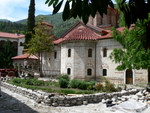
More pictures here
|
|
The BACHKOVO Monastery "Uspenie
Bogorodichno" -
Peakview.bg |


Erected in a magnificent locality
along the
reaches of the Assenitsa River (29 km south
of Plovdiv), the Bachkovo monastery ranks
second after the Rila Monastery both with
regard to size, and to architectural, artistic and literary
signifi-
cance. It was founded by the Georgian
Grigorii Bakuriani in 1083.
Almost immediately after its foundation, the monastery turned into
a wealthy landowner, its properties stretching as far as Salonika.
In 1344 Tsar Ivan Alexander
established his rule over the Rodo-
pite, populated the monastery with Bulgarians, and generously
donated to it. His full-length portrait stands next to the figures
of
Bakuriani and his brother Apassii in the narthex, of the upper
floor
of the ossuary - the only building remained from the mediaeval
monastery after its destruction in 16th c. standing alone in the
woods today, apart from the new "complex". Spared during the
first wave of enslavement Bachkovo monastery became the pri-
son of the last Bulgarian Patriarch
Euthymius, who was exiled
here, where he continued his literary work.
FULL article here
Source:
http://www.peakview.bg/monasteries/bach_l.htm |
|
| |
The preserved murals on two
floors are a valuable
document of an age that has left us with fairly few
artistic testimonies. Painted during 11th and 12th
centuries, the murals are result of a monumental-
spiritualistic style of the time when the theocratic
system of the Byzantine rule was most powerful:
stern figures, foreign to all worldly things, forceful
and severe drawing, enamel gleaming colour.
|
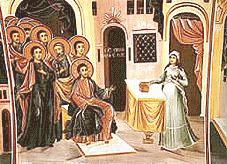 |
Links to:
|
Bachkovo
Monastery
|
Zograph
Monastery
|
Drynovo
Monastery
|
Sokolovo
Monastery
|
|
Rojen
monastery
|
Aladja monastery
|
Glojenski
monastery
|
Cherepish
monastery
|
|
